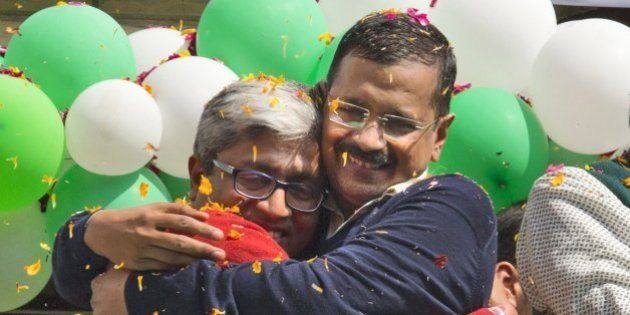
On the day of the third anniversary of the Aam Aadmi Party, Akhilesh Tripathi became its fifth MLA to be sent to jail. For a lot of people, this will be a sign of how the Aam Aadmi Party is opposite of what it claims to be. For its supporters and volunteers, it will be a sign of the kind of sacrifices they have to make in a radical party that hasn’t been afraid to play the cat-and-mouse game with Delhi Police. For many, it is just another example of the AAP’s inability to keep controversy at bay.
Three years ago, the India Against Corruption Movement announced its transformation into a political party. The critics used to say the Lokpal movement should join politics instead of dictating it from outside the political space. After IAC gave way to AAP, the same critics started saying, look, they always had ulterior political intentions.
The Aam Aadmi Party has never been afraid of controversy or criticism, but there’s a difference in the kind of controversy and criticism they elicit now. Today it is about whether Arvind Kejriwal is compromising his position on corruption with Lalu. Three years ago, the debate used to be whether the Aam Aadmi Party can win an election on the issue of corruption alone, whether its radical attack on private electricity companies in Delhi was good for the economy, and whether the party can win more than a handful seats in Delhi, whether it was a B-team of the Congress or the BJP.

AAP 3.0
What has changed from then to now is that AAP has become a party of governance, and has thus lost its radical edge. The Aam Aadmi Party of yore went about making accusations and exposing scams faster than the news cycle could keep pace with. Arvind Kejriwal’s oft-repeated cliché, “sab mile huey hain,” showed there were no holy cows for the party. It was a party of agitation and mobilisation. "Such is realpolitik. Except that we thought the AAP was different. To use Delhi lingo, feel nahi aa rahi.
When a party is in power, the party organisation becomes a daily defender and propagandist of its government. When it is out of power, it becomes a challenger that starts talking about saving the nation. Such is realpolitik. Except that we thought the AAP was different. To use Delhi lingo, feel nahi aa rahi.
When Arvind Kejriwal became CM and sat on a dharna on the streets to demand the Delhi Police listen to him, he was called anarchist and immature, unfit to be CM, the media turned against him, and public opinion didn’t seem to like it either. Despite hastily resigning to contest the Lok Sabha elections, the AAP managed to win 67 of 70 seats the next time, soon after the Modi wave. The credit for this goes to what the AAP showed in its 49 day government the first time round: check corruption and take on the electricity companies. Going through this see-saw experience, the AAP seems to have decided it is better to let good governance speak. Good governance has a very low bar in India. Don’t listen to the middle class, keep the poor happy with a few schemes, and you can easily win elections.

Punjab and Beyond
In Punjab, the AAP is surprising its critics every passing day. The assembly elections there are a year away, the Congress has just about settled its internal factionalism, the SAD-BJP is facing anti-incumbency. The AAP is campaigning in full swing.
If the AAP wins Punjab, it will have killed many birds with one stone. Firstly, it will prove that it is not merely a Delhi party, and is capable of doing well in a place that is not a small city-state. Secondly, it will get a chance to rule a real state, one where the police force is answerable to the state government. Thirdly, ruling two states will making the AAP look a far serious contender for the parliament. "Far from the heady idealism, of three years ago, today’s AAP is authoritarian and undemocratic like any other Indian political party."
The Aam Aadmi Party of yore seemed like an ideologically diverse set of people who in turn attracted different kinds of people. This raised hopes of a new umbrella party, the only other example of which is the original idea of the Indian National Congress. Far from the heady idealism, of three years ago, today’s AAP is authoritarian and undemocratic like any other Indian political party.

The most shameful episode in the AAP’s three year long history was sacking of Yogendra Yadav and Prashant Bhushan in the most undemocratic and unsavoury manner. There wasn’t even the pretence of democracy or tolerance of dissent. That moment was a turning point, making it clear that it was Arvind Aadmi Party. There may be a good case to be made for political parties to be run like sole proprietorship firms, but then again, this is not how IAC/AAP said they were going to be. "The most shameful episode in the AAP’s three year long history was sacking of Yogendra Yadav and Prashant Bhushan in the most undemocratic and unsavoury manner."
A high-command driven party is able to save itself from its factional wars, but the trouble with this model is that it finds itself difficult to expand. This is partly the reason why the AAP can’t become a pan-India party with the kind of speed with which it became Delhi’s party of governance. Arvind Kejriwal can’t possibly look at party activities in every state, and so the party is concentrating on its best bet, Punjab. Kejriwal has announced that it is not in the race for Lok Sabha 2019, but don’t be surprised if ‘the party’ changes its mind after winning Punjab.
The AAP needs to learn better how to handle success: its first Delhi election in 2013 emboldened it to go national. To do this, Kejriwal resigned as Delhi CM and contested Varanasi against Modi. The moniker ‘bhagoda’ scared him and the party so much they seemed to have given up their national ambitions, and want to take it slow, one state at a time. The party’s second success, winning 67 of 70 seats in Delhi early this year, gave it the arrogance with which it fired Yadav and Bhushan. If it wins Punjab, not being in the race for 2019 will be difficult.



Contact HuffPost India
Also see on HuffPost:
